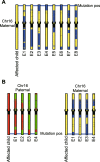scHaplotyper: haplotype construction and visualization for genetic diagnosis using single cell DNA sequencing data
- PMID: 32007105
- PMCID: PMC6995221
- DOI: 10.1186/s12859-020-3381-5
scHaplotyper: haplotype construction and visualization for genetic diagnosis using single cell DNA sequencing data
Abstract
Background: Haplotyping reveals chromosome blocks inherited from parents to in vitro fertilized (IVF) embryos in preimplantation genetic diagnosis (PGD), enabling the observation of the transmission of disease alleles between generations. However, the methods of haplotyping that are suitable for single cells are limited because a whole genome amplification (WGA) process is performed before sequencing or genotyping in PGD, and true haplotype profiles of embryos need to be constructed based on genotypes that can contain many WGA artifacts.
Results: Here, we offer scHaplotyper as a genetic diagnosis tool that reconstructs and visualizes the haplotype profiles of single cells based on the Hidden Markov Model (HMM). scHaplotyper can trace the origin of each haplotype block in the embryo, enabling the detection of carrier status of disease alleles in each embryo. We applied this method in PGD in two families affected with genetic disorders, and the result was the healthy live births of two children in the two families, demonstrating the clinical application of this method.
Conclusion: Next generation sequencing (NGS) of preimplantation embryos enable genetic screening for families with genetic disorders, avoiding the birth of affected babies. With the validation and successful clinical application, we showed that scHaplotyper is a convenient and accurate method to screen out embryos. More patients with genetic disorder will benefit from the genetic diagnosis of embryos. The source code of scHaplotyper is available at GitHub repository: https://github.com/yzqheart/scHaplotyper.
Keywords: Haplotyping; Preimplantation genetic diagnosis; Single cell DNA sequencing; Single gene disorder.
Conflict of interest statement
The authors declare that they have no competing interests.
Figures


Similar articles
-
Clinical application of NGS-based SNP haplotyping for the preimplantation genetic diagnosis of primary open angle glaucoma.Syst Biol Reprod Med. 2019 Jun;65(3):258-263. doi: 10.1080/19396368.2019.1590479. Epub 2019 Apr 12. Syst Biol Reprod Med. 2019. PMID: 30977407
-
Multi-centre evaluation of a comprehensive preimplantation genetic test through haplotyping-by-sequencing.Hum Reprod. 2019 Aug 1;34(8):1608-1619. doi: 10.1093/humrep/dez106. Hum Reprod. 2019. PMID: 31348829
-
The clinical application of single-sperm-based SNP haplotyping for PGD of osteogenesis imperfecta.Syst Biol Reprod Med. 2019 Feb;65(1):75-80. doi: 10.1080/19396368.2018.1472315. Epub 2018 May 15. Syst Biol Reprod Med. 2019. PMID: 29764212
-
Should every embryo undergo preimplantation genetic testing for aneuploidy? A review of the modern approach to in vitro fertilization.Best Pract Res Clin Obstet Gynaecol. 2018 Nov;53:38-47. doi: 10.1016/j.bpobgyn.2018.07.005. Epub 2018 Jul 25. Best Pract Res Clin Obstet Gynaecol. 2018. PMID: 30146380 Review.
-
Preimplantation Genetic Screening and Preimplantation Genetic Diagnosis.Obstet Gynecol Clin North Am. 2018 Mar;45(1):113-125. doi: 10.1016/j.ogc.2017.10.009. Obstet Gynecol Clin North Am. 2018. PMID: 29428279 Review.
Cited by
-
Concurrent Preimplantation Genetic Testing and Competence Assessment of Human Embryos by Transcriptome Sequencing.Adv Sci (Weinh). 2024 Aug;11(32):e2309817. doi: 10.1002/advs.202309817. Epub 2024 Jun 20. Adv Sci (Weinh). 2024. PMID: 38900059 Free PMC article.
-
Clinical practice and outcomes of preimplantation genetic testing for CMT1A using a novel direct detection method.Heliyon. 2023 Nov 10;9(11):e22196. doi: 10.1016/j.heliyon.2023.e22196. eCollection 2023 Nov. Heliyon. 2023. PMID: 38045147 Free PMC article.
-
Outcomes and the effect of PGT-M in women with hormone-related hereditary tumor syndrome.Front Oncol. 2024 May 10;14:1378019. doi: 10.3389/fonc.2024.1378019. eCollection 2024. Front Oncol. 2024. PMID: 38800375 Free PMC article.
-
Pairwise comparative analysis of six haplotype assembly methods based on users' experience.BMC Genom Data. 2023 Jun 29;24(1):35. doi: 10.1186/s12863-023-01134-5. BMC Genom Data. 2023. PMID: 37386408 Free PMC article.
-
A comprehensive PGT-M strategy for ADPKD patients with de novo PKD1 mutations using affected embryo or gametes as proband.J Assist Reprod Genet. 2021 Sep;38(9):2425-2434. doi: 10.1007/s10815-021-02188-z. Epub 2021 May 3. J Assist Reprod Genet. 2021. PMID: 33939064 Free PMC article.
References
-
- Backenroth D, Zahdeh F, Kling Y, Peretz A, Rosen T, Kort D, Zeligson S, Dror T, Kirshberg S, Burak E, et al. Haploseek: a 24-hour all-in-one method for preimplantation genetic diagnosis (PGD) of monogenic disease and aneuploidy. Genet Med. 2019;21(6):1390–1399. doi: 10.1038/s41436-018-0351-7. - DOI - PubMed
-
- Masoud Zamani Esteki AADA, Ding ASPK, Yves Moreau JRV. HiVA: an integrative wet- and dry-lab platform for haplotype and copy number analysis of single-cell genomes. bioRxiv. 2019;564914.
Publication types
MeSH terms
Substances
Grants and funding
LinkOut - more resources
Full Text Sources
Medical
Miscellaneous

